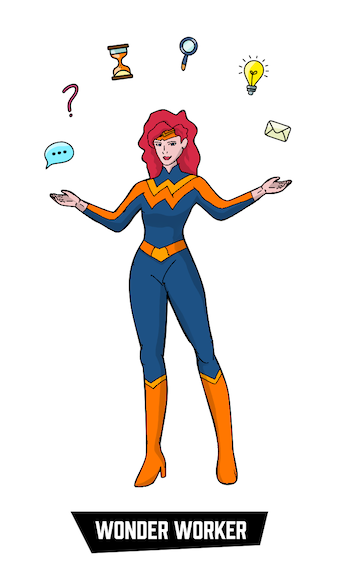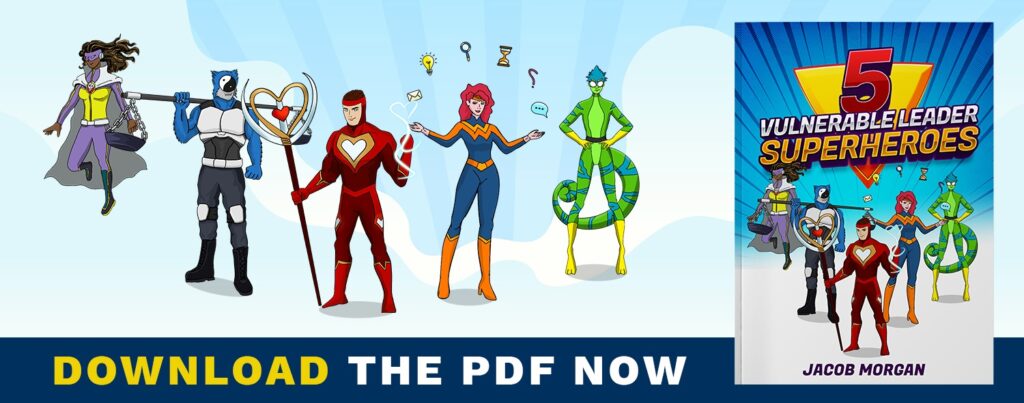In my new book, Leading With Vulnerability, I interviewed over 100 CEOs around the world and surveyed nearly 14,000 employees in partnership with DDI. The goal of the book was to explore how to tap into vulnerable at work in the RIGHT. If you only focus on vulnerability you will perceived as incompetent and if you only concentrate on competence you will be perceived as a robot. Instead, leaders must be able to focus on both, competence and connection, but how do you do that?

A vulnerable leader is a leader who intentionally opens themselves up to the potential of emotional harm while taking action to create a positive outcome when possible.
I discovered that vulnerability at work takes on different shapes and sizes, specifically 5 of them! I consider all 5 of these vulnerable leaders to be superheroes and like any superhero they all have their strengths and weakness. I put together a free PDF which breaks down all 5 of them including their strengths and weakness.
Read through each one of them and let me know which you are most comfortable with being.
Meet Wonder Worker

Wonder Worker is more comfortable being vulnerable around all things work related.
This means they are comfortable saying “I don’t know,” asking for help, talking about work-related mistakes or failures, and giving and receiving candid feedback. They are not as comfortable sharing personal information or anything that falls outside of the context of work, it doesn’t mean they never will, but it requires them really getting outside of their comfort zone to do so. Wonder Worker prefers to have more established boundaries between work and life and tends to be more private with their personal life.
This type of leader is great at connecting with people on a professional level and creating a strong culture focused on learning and growth. Because Wonder Worker has a strong focus on learning, growth, and improvement at work, they are able to create very effective and productive teams and can unlock the potential of those around them.
They are also a master of boundaries.
However, if you are a Wonder Worker, your team members may feel like they don’t know the “real you” since most of what you share tends to be focused on work. You may also struggle with creating very high levels of trust and belonging. Lastly, you may find maintaining boundaries to be a challenge over time as you constantly work to balance your personal and professional self.
Abilities:
- Connects with people on a professional level.
- Creates a culture of learning and growth.
- A master of boundaries.
- Gets the most out of people.
- Builds strong and productive teams.
- Great at driving results.
Weaknesses:
- Others may feel they don’t know the “real you.”
- May not create as high levels of trust and belonging.
- Can be challenging to maintain boundaries.
- Might not get or give emotional support at work.
Stephen Smith is the CEO of Amsted Industries, a global manufacturing company with over 18,000 employees. He is one of the many Wonder Worker superheroes.
“I’m not as good at sharing things about my personal life as I should be because I’m a private person by nature. But I do understand that sharing some things are insights into your own life and that these are really valuable in the organization. I just had my second grandchild and I’m around the office showing pictures on my phone to people who normally wouldn’t even expect to interact with me. I want my team to know that I’m a human being like they are and I get joy out of the same kinds of things that they do and I feel the same emotions. I’m also not shy about telling people that I’m a big White Sox fan which isn’t very common in Chicago! I try to be more open and share about my life in a way with which I am comfortable.”
The 5 superheroes are: Captain Heart, Professor Personal, Super Situational, Wonder Worker, and Balanced Beast. Download the PDF to learn about all of the 5 Vulnerable Leader Superheroes and which one you are most comfortable with. Knowing this will allow you to improve team dynamics and help you figure out what projects you should work on, how you should work, and what kind a leader you have the potential to become. Get the PDF here.

Comments